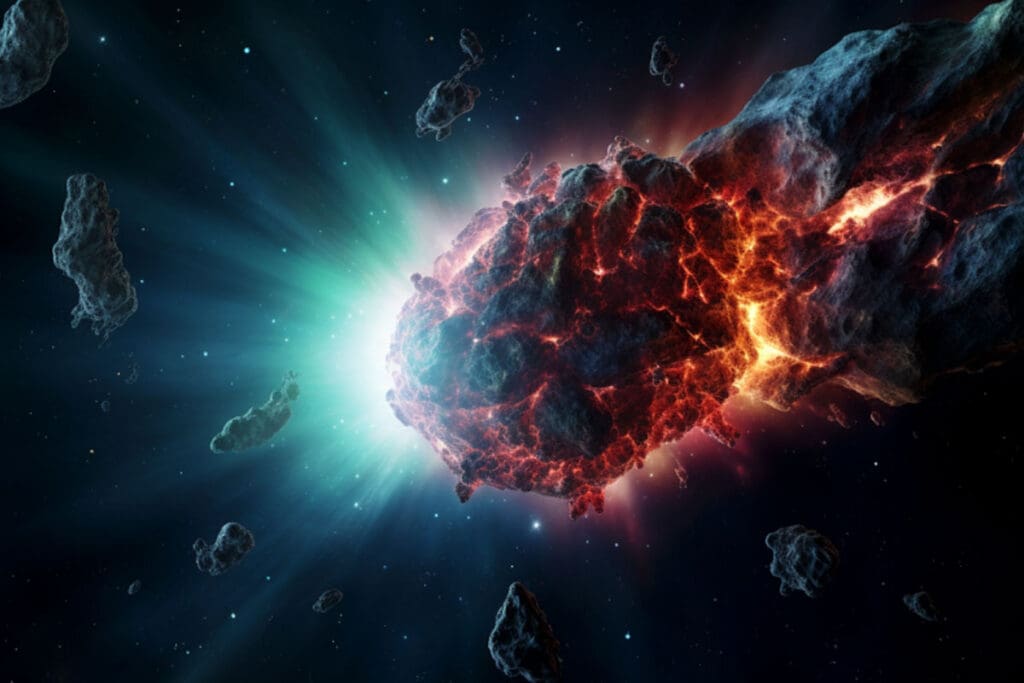
Depending on one’s location, on December 11 or 12, Asteroid 319 Leona will pass in front of the constellation of Orion the Hunter. The asteroid will block Earth’s view of Betelgeuse, the most famous red supergiant star of the Orion constellation and one of the sky’s brightest. Betelgeuse is the night sky’s 10th-brightest star.
Observers along a narrow path will see Betelgeuse become fainter, or even disappear for up to 12 seconds. The narrow path for observers will be in southern Europe and across the Atlantic Ocean into the Bahamas, southern Florida, and part of Mexico, according to EarthSky.org.
In the northern hemisphere, the occultation is estimated to occur around 8:17 p.m. EST, according to Sky & Telescope. However, that time could shift by a few minutes as the estimate of the orbit of 319 Leona becomes refined.
Read More: 4.5-Billion-Year-Old Space Rocks Dropped Off by Mother Ship — What NASA Hopes to Learn
Where to Find Betelgeuse in the Night Sky
Betelgeuse is in the Orion constellation, also known as Orion the Hunter. The star sits at the location of the constellation where the top of the hunter’s chest intersects with its neck.
To locate Betelgeuse from the northern hemisphere during December, start about two hours after sunset. Look due east and you’ll spot the three stars of Orion’s belt. To their left, Betelgeuse will be east and slightly higher than the lowest (nearest the horizon or southernmost) and easternmost star in Orion’s belt, Alnitak.
The International Occultation Timing Association has a special page dedicated to the event. The site features a Google Earth file showing the complete path that’s available for download.
There is also an interactive simulator online that will allow people to observe what the event will look like. They will see variations depending on their location from the centerline and on the size of Leona and Betelgeuse.
“Blink Out” Will Help Astronomers Map Betelgeuse
Through this temporary “blinking out” or occultation, Betelgeuse will give astronomers a valuable opportunity to create a map of the giant red star’s surface.
“We will be hopefully able to learn more about its large convective cells, which is driving its variable brightness,” said astrophysicist Gianluca Masi, director of The Virtual Telescope Project in a statement.
Astronomers hope to learn more about both Betelgeuse and Leona. Currently, the size and shape of both are uncertain. Scientists hope this pass-by will help them learn more about their sizes, as well as other features.
“By precisely timing the duration of the occultation from many sites simultaneously, astronomers can refine their knowledge of the size and shape of the asteroid. They may even be able to map Betelgeuse’s strangely large convective cells, by which the star brightens and darkens for months at a time,” Sky & Telescope reported. “As the asteroid moves across the stellar disk, it will cross over large convection cells, which are brighter than most of the star’s visible surface. Thus, measuring the brightness of the star throughout the occultation will prove vital.”
“We might even obtain information on the distribution of these cells and see if these can explain Betelgeuse’s mass-loss observed with large telescopes,” Miguel Montargès from the Paris Observatory said. “This result will be unprecedented since there is no visible-light interferometer allowing such an observation to be made.”
Astronomers Observe Alarming Behavior from Betelgeuse
In 2019, astronomers noted that Betelgeuse visibly dimmed. By February 2020, Betelgeuse had lost two-thirds of its normal luminosity as observed from Earth. The loss of light wasn’t due to an occultation caused by an asteroid passing by as will occur on December 12, 2023. It was something serious.
A new analysis has discovered that Betelgeuse, located about 530 light-years from Earth, suffered a blowout and is still recovering from the event. According to researchers, Betelgeuse is nearing the end of its stellar life. The red supergiant star will eventually explode in a supernova that will be visible from Earth. When that happens, it will shine as bright as a half-moon for more than three months. Because of its distance from Earth, it will cause no harm to life on the blue planet. However, scientists also say that it could take another 100,000 years before Betelgeuse explodes in the supernova, according to research in 2021.
Astronomers ultimately concluded that the dimming of Betelgeuse was not a sign that it was going to immediately supernova. Instead, they say the loss of two-thirds of the Betelgeuse’s luminosity was the result of a giant dust cloud obscuring some of the star’s light.
About Betelgeuse
Betelgeuse is a red supergiant star. It is one of the largest visible to the naked eye. It is usually the tenth-brightest star in the night sky. The star is the second-brightest in the constellation of Orion, with the brightest being Rigel. Betelgeuse is of the spectral type M1-2.
In terms of size, calculations of Betelgeuse’s mass range from under ten to a little over twenty times that of the sun.
Astronomers estimate that the distance from the sun to Betelgeuse lies somewhere around 500-600 lightyears.
The three stars that make up Orion’s belt from east to west are Alnitak (magnitude 1.8), Alnilam (magnitude 1.7), and Mintaka (magnitude 2.2).
About Asteroid 319 Leona
Asteroid 319 Leona (provisional designation A920 HE) is a dark asteroid and also comes under the designation of a minor planet. This tumbling, slow rotator comes from the outermost regions of the asteroid belt. Leona’s size is estimated at 70 kilometers in diameter. It is one of the top 100 slowest rotators known to exist.
Leona was first discovered on October 8, 1891, by French astronomer Auguste Charlois at Nice Observatory in southeastern France.
Leona orbits the Sun in the outer main belt once every 6 years and 3 months (2295 days).









